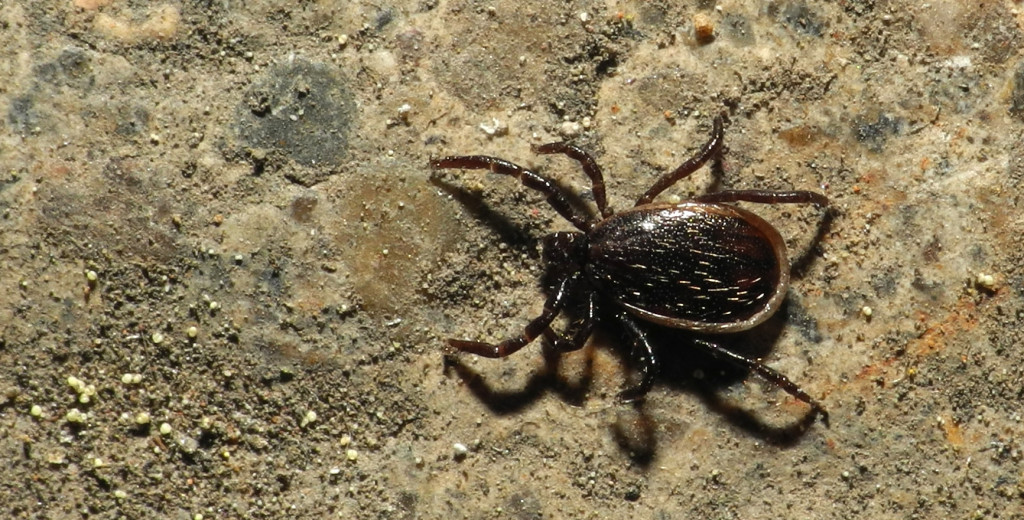One of the sports of my childhood was the capture of lizards. Horned toads were common prey until the pet trade made them scarce: few were able to keep them in the ants they craved, so most died in captivity. Alligator lizards invited a special challenge because they fought back. One fellow I knew bragged that he caught them by getting them to bite him. But most of us were content with what we called blue-bellies or the Western Fence Lizard, a little gentleman that we found underneath rocks and large pieces of wood. (How we never bumbled into a rattlesnake is a minor miracle.)
Category Archives: Insects and Arachnids
The Latest Tick Horror Story
File this under “reasons to be glad that I am not an Eastern Woodlands Hiker”:
People have been turning up at Long Island allergists with an unusual complaint: they are suddenly sensitive to eating red meat. A trip to Burger King might cause them serious stomach distress. These people are not vegetarians or vegans on a holiday: they are people for whom steaks, burgers, and roast beef have been a mainstay of their diet. One doctor has seen nearly 200 cases so far this year.
The originator of the autoimmune system going haywire is the Lone Star Tick. Readers of this blog know that I hate ticks. This one scares me because I do consume a weekly steak. My first experiences with ticks happened in the Southeast where this particular species is spreading rapidly.
Spider Wasp
Birds subdued their calls. I saw no tracks other than boots and bicycle treads, so I dedicated the day to understanding the landscape. My pocket notebook was filling up with entries about the geology of Whiting Ranch — how the ridges north of Dreaded Hill came in waves, each of them consisting of a different geological formation. A loud buzz startled me from my observations. A blue-black insect the size of a bumblebee shot out of the sage scrub and zoomed down the road toward me, zigzagging before it hit me. I followed it — first by sight, then by foot — as it flew a little further and alighted on the stubble at the edge of the road.
Tick Removal
I remember reading about how the head of Duke University’s Medical School died of Rocky Mountain Spotted Fever because a tick bit him and he didn’t realize it.
The fever and vomiting begin early. It is not until it has nearly killed you that the infamous spots appear. That is the start of the death knell.
So nothing creeps me out quite like finding a tick on my person. Or the dog. Or you.
Continue reading
Been Around a Long Time
A followup to my post about spirochetes and ticks:
We think of Lyme Disease as a particularly human affliction. Nonetheless, it was only identified 40 years ago. Studies of ticks preserved in amber revealed that the spirochete predated humans by 15 million years! Science Daily reported:
“Ticks and the bacteria they carry are very opportunistic,” said George Poinar, Jr., a professor emeritus in the Department of Integrative Biology of the OSU College of Science, and one of the world’s leading experts on plant and animal life forms found preserved in amber. “They are very efficient at maintaining populations of microbes in their tissues, and can infect mammals, birds, reptiles and other animals.
“In the United States, Europe and Asia, ticks are a more important insect vector of disease than mosquitos,” Poinar said. “They can carry bacteria that cause a wide range of diseases, affect many different animal species, and often are not even understood or recognized by doctors.
“It’s likely that many ailments in human history for which doctors had no explanation have been caused by tick-borne disease.”
Dr. Poinar found evidence of spirochetes in tick specimens fossilized in Dominican amber. He also discovered evidence of Rickettsia bacteria — which are the cause of Rocky Mountain Spotted Fever. The discovery pushes our knowledge of such pathogens presence back from 5,300 years — the age of the Tyroleon Ice Man who was sick with Lyme Disease.
Ticks and their pathogens been waiting for us for a long time…. When they bite you, you are being bitten by History.
Borrelia miyamotoi
When I spent four years in North Carolina about 35 years ago, I hated going into the woods because doing so without a hat invited ticks to drop on my head. I remember one long post-hike affair when my girlfriend and I stripped ourselves naked and spent a distinctly unerotic hour searching for the vectors on our skin and in our various hairy bits. We broke up shortly afterwards, though not because of the ticks, I think. The plastic helmet that I started to wear to protect myself proved a more decisive factor — among many.
Ticks scare me. Just the thought of a creature burrowing its head into my body and sucking deeply from the nearest capillary gives me no happy thrill. I shivered when my dog’s veterinarian found one attached to his neck. It looked like a lump of grayish brown dog flesh to me. I backed off when he raised it to show to me. Good thing, I thought, that I didn’t let my Boston Terrier sleep with me. Who wanted to become a second course to a known carrier of Lyme Disease?



